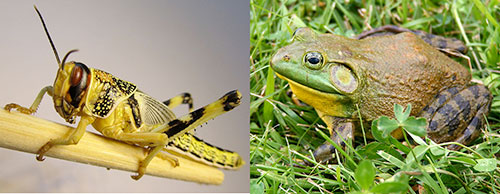
New research may explain why frogs and grasshoppers have such different "springs" for jumping.
Wikimedia commons: AtelierMonpli, Carl D. Howe
PROVIDENCE, R.I. [Brown University] — A new research paper tells a story of the grasshopper and the bullfrog, but it’s no children’s tale. Instead, it describes biomechanical simulations that help to explain why the two jumping animals have very different stiffnesses in the springs — tendons in the frogs and tendon counterparts called apodemes in the grasshoppers — that store energy for their leaps. The difference, the science suggests, is the time they typically take before they take off.
“Our simulation is in line with the hypothesis that spring stiffness varies among organisms according to their jumps — whether they are time-limited or non-time-limited,” said Michael Rosario, a Brown University postdoctoral fellow and lead author of the study in the Proceedings of the Royal Society B.
Scientists already knew that the key spring in the grasshopper (the apodeme and part of its exoskeleton) has more than twice the stiffness as the analogous tendon in the bullfrog. By simulating the muscle-spring systems in each creature’s legs, Rosario and his co-authors were able to show that the more time an animal has to contract muscle to store up energy before jumping, the more energy they can store in a relatively stiff spring.
Grasshoppers (Schistocerca gregaria) will normally spend 300 milliseconds storing up energy in their muscles, apodemes, and exoskeletons, although they have to jump more quickly, and perhaps less efficiently, to evade predators. Bullfrogs (Lithobates catesbeiana), on the other hand, normally spend only 50 milliseconds before making a leap, for instance to pounce toward prey. The simulations showed the greatest energy storage for a quick jump like that of the bullfrog was in a less stiff spring, while for the grasshopper’s timeframe it was in a stiffer spring.
In other words, the creatures have the spring stiffness they should, given the time constraints on their typical jumping behavior.
“For both the bullfrog and the grasshopper, the time available for muscle contraction determined which spring stiffness permitted maximal energy storage,” wrote Rosario and colleagues at Duke University (where he did most of the research before completing it at Brown), the University of Bristol, North Carolina State University and the University of North Carolina.
Rosario and his colleagues argue that the paper may help predict muscle and tendon properties for other organisms, including mammals. Further research, which Rosario is conducting in the lab of Brown University Professor Thomas Roberts, will determine whether that’s too much of a leap.
In addition to Rosario, the paper’s other authors are Gregory Sutton at Bristol, Sheila Patek at Duke and Gregory Sawicki in North Carolina.
The Department of Energy (FG02-97ER25308) and the National Science Foundation (IOS-1439850) supported the research.